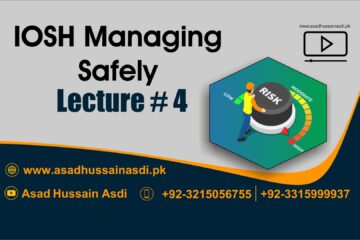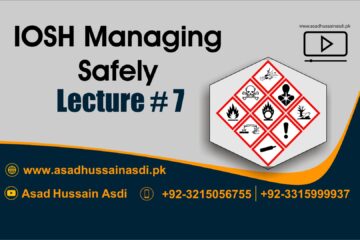ProQual Level 3 Diploma in Energy Management Course in Islamabad || Registration Open
Registration Open= +92-3315999937, +92- 3215056755 (WhatsApp Only)
Introduction
The aim of the Level 3 Diploma in Energy Management qualification is to equip candidates
with a broad basic understanding of the core areas of energy management.
This qualification is aimed at those entering the profession, for example, through the
recently approved Junior Energy Manager Trailblazer Apprenticeship, or as a standalone
energy management qualification for individuals working in, for example, the areas of
facilities management, property or environmental services.
Achievement of the qualification enables candidates to apply for membership of energy
management professional bodies, such as the Energy Managers Association (EMA)
The awarding organisation for this qualification is ProQual AB. This qualification is regulated
by the Office of Qualifications and Examinations Regulation (Ofqual) and the Council for the
Curriculum Examinations and Assessment (CCEA) Regulation. The Regulated Qualifications
Framework (RQF) includes those qualifications regulated by Ofqual and CCEA Regulation.
Entry Requirements
There are no formal entry requirements for this qualification.
Centres should carry out an initial assessment of candidate skills and knowledge to identify
any gaps and help plan the assessment.
Qualification Profile
Qualification title ProQual Level 3 Diploma in Energy Management
Ofqual qualification number 601/8098/5
Level 3
Total Qualification Time 360
Assessment
Pass or fail
Internally assessed and verified by centre staff
External quality assurance by ProQual verifiers
Qualification start date 1/11/15
Qualification end date
ProQual, April 2020
Level 3 Diploma in Energy Management
4
Qualification Structure
To achieve the Level 3 Diploma in Energy Management, candidates must complete all 11 of
the following Mandatory Units:
H/507/9083 Energy Management : An Introduction
K/507/9084 Energy Management : Technical and Operational
M/507/9085 Energy Management : Energy Assessments, Measurements and Verification
T/507/9086 Energy Management : Behavioural Change and Motivation
A/507/9087 Energy Management : Regulatory & Legal Compliance and Carbon Management
F/507/9088 Energy Management : Strategy/Plan
J/507/9089 Energy Management : Waste Management
A/507/9090 Energy Management : Procurement
F/507/9091 Energy Management : Transport
J/507/9092 Energy Management : Water
L/507/9093 Energy Management : Information & Communications Technology
Each of the above units also form separate qualifications (listed below), refer to the Level 3
Awards in Energy Management Specification for further details.
601/9098/3 ProQual Level 3 Award in Energy Management : An Introduction
601/8109/6 ProQual Level 3 Award in Energy Management : Technical and Operational
601/8104/7 ProQual Level 3 Award in Energy Management : Energy Assessments, Measurements
and Verification
601/8103/5 ProQual Level 3 Award in Energy Management : Behavioural Change and Motivation
601/8107/2 ProQual Level 3 Award in Energy Management : Regulatory & Legal Compliance and
Carbon Management
601/8108/4 ProQual Level 3 Award in Energy Management : Strategy/Plan
601/8111/4 ProQual Level 3 Award in Energy Management : Waste Management
601/8106/0 ProQual Level 3 Award in Energy Management : Procurement
601/8110/2 ProQual Level 3 Award in Energy Management : Transport
601/8112/6 ProQual Level 3 Award in Energy Management : Water
601/8105/9 ProQual Level 3 Award in Energy Management : Information & Communications
Technology
ProQual, April 2020
Level 3 Diploma in Energy Management
5
Centre Requirements
Centres must be approved to offer this qualification. If your centre is not approved please
complete and submit form ProQual Additional Qualification Approval Application.
Staff
Staff delivering this qualification must be appropriately qualified and occupationally
competent.
Assessors/Internal Quality Assurance
For each competence-based unit centres must be able to provide at least one assessor and
one internal quality assurance verifier who are suitably qualified for the specific
occupational area. Assessors and internal quality assurance verifiers for competence-based
units or qualifications will normally need to hold appropriate assessor or verifier
qualifications, such as:
- ProQual Level 3 Certificate in Teaching, Training and Assessment
- Award in Assessing Competence in the Work Environment
- Award in Assessing Vocationally Related Achievement
- Certificate in Assessing Vocational Achievement
- Award in the Internal Quality Assurance of Assessment Processes and Practices
- Certificate in Leading the Internal Quality Assurance of Assessment Processes and
Practices
Support for Candidates
Materials produced by centres to support candidates should:
- enable them to track their achievements as they progress through the learning
outcomes and assessment criteria;
- provide information on where ProQual’s policies and procedures can be viewed;
- provide a means of enabling Internal and External Quality Assurance staff to
authenticate evidence
ProQual, April 2020
Level 3 Diploma in Energy Management
6
Assessment
Candidates must demonstrate the level of knowledge described in each unit. Assessment is
the process of measuring a candidate’s knowledge and understanding against the standards
set in the qualification.
Each candidate is required to produce evidence which demonstrates their achievement of
all of the learning outcomes and assessment criteria for each unit.
Evidence can include: – assignments/projects/reports
– worksheets
– portfolio of evidence
– record of oral and/or written questioning
– candidate test papers
Learning outcomes set out what a candidate is expected to know, understand or be able to
do.
Assessment criteria specify the standard a candidate must meet to show the learning
outcome has been achieved.
Learning outcomes and assessment criteria for this qualification can be found from page 8
onwards.
There must be valid, authentic and sufficient for all the assessment criteria. However, one
piece of evidence may be used to meet the requirements of more than one learning
outcome or assessment criterion.
Internal Quality Assurance
An internal quality assurance verifier confirms that assessment decisions made in centres
are made by competent and qualified assessors, that they are the result of sound and fair
assessment practice and that they are recorded accurately and appropriately.
Adjustments to Assessment
Adjustments to standard assessment arrangements are made on the individual needs of
candidates. ProQual’s Reasonable Adjustments Policy and Special Consideration Policy sets
out the steps to follow when implementing reasonable adjustments and special
considerations and the service that ProQual provides for some of these arrangements.
Centres should contact ProQual for further information or queries about the contents of the
policy.
ProQual, April 2020
Level 3 Diploma in Energy Management
7
Results Enquiries and Appeals
All enquiries relating to assessment or other decisions should be dealt with by centres, with
reference to ProQual’s Enquiries and Appeals Procedures.
Certification
Candidates who successfully complete all of the Mandatory Units required for this
qualification will be awarded a certificate giving the full qualification title –
ProQual Level 3 Diploma in Energy Management
Claiming certificates
Centres may claim certificates for candidates who have been registered with ProQual and
who have successfully completed all of the units. All certificates will be issued to the centre
for successful candidates.
Replacement certificates
If a replacement certificate is required a request must be made to ProQual in writing.
Replacement certificates are labelled as such and are only provided when the claim has
been authenticated. Refer to the Fee Schedule for details of charges for replacement
certificates.
ProQual, April 2020
Level 3 Diploma in Energy Management
8
Learning Outcomes and Assessment Criteria
H/507/9083 Energy Management: An Introduction
Learning Outcome – The learner will: Assessment Criterion – The learner can:
1 Understand the fundamentals of
energy management
1.1 Define what energy is
1.2 Identify different types of energy
1.3 Define what carbon emissions are
1.4 Define what energy management is
1.5 Identify the importance of core energy management
competencies, including: Technical and Operational,
Energy Assessment and Measurement & Verification,
Behavioural Change and Motivation, Regulatory and
Legal Compliance and Carbon Management, Strategy
and Plan, Waste Management, Procurement,
Transport, Water and ICT
1.6 Explain the role of an energy manager
1.7 Describe the process of energy reporting
1.8 Describe how energy reporting can contribute to
reducing energy consumption
2 Understand energy consumption in
the workplace
2.1 Describe various ways that energy is used in the
workplace
2.2 Explain how energy use varies with respect to
equipment used in the workplace
2.3 Describe the typical inefficiencies in energy
consumption in working environments
2.4 Describe how energy consumption can be measured
in the workplace
2.5 Explain what energy saving practices can be
introduced to reduce energy consumption
2.6 Explain organisational benefits of the reduction of
energy consumption
3 Understand obstacles to reducing
energy consumption in the
workplace
3.1 Explain the key obstacles to reducing energy
consumption in the workplace
3.2 Describe what actions can be taken to overcome the
key obstacles to reducing energy consumption
3.3 Identify different channels used for stakeholders’
engagement
4 Understand common energy use
systems in the workplace
4.1 Outline common energy use systems
4.2 Describe how common energy use systems operate
4.3 Outline opportunities for improvement of energy use
systems in workplace
5 Understand the importance of
collecting and managing energy data
5.1 Describe where to find energy data
5.2 Describe how to collect energy data
ProQual, April 2020
Level 3 Diploma in Energy Management
9
Learning Outcome – The learner will: Assessment Criterion – The learner can:
5.3 Identify different types of meters
5.4 Identify individual identifiers of meters
5.5 Describe an energy bill and its elements, including the
meter’s individual identifiers
5.6 Describe different types of data collection methods
6 Understand the importance of
energy audits and assessments in
the workplace
6.1 Explain the framework for carrying out an energy
audits
6.2 Describe approaches to energy assessments
6.3 Demonstrate an understanding of energy audits and
assessments as means of identifying opportunities to
improve energy performance
7 Understand the importance of
energy consumption awareness in
the workplace
7.1 Identify opportunities of raising energy consumption
awareness in the workplace
7.2 Describe various channels of disseminating energy
awareness across the workplace
8 Understand the key legislative and
regulatory requirements covering
energy in the UK
8.1 Identify what legislation is in place to reduce energy
consumption and carbon emissions
9 Understand the importance of an
organisation’s energy strategy,
planning and policy
9.1 Explain the importance of an organisation’s energy
strategy, planning and policy
9.2 Outline an organisation’s energy objectives and
targets
9.3 Identify the benefits of an organisation’s energy
strategy, planning and policy
9.4 Identify global energy trends and their impact of
organisational setting
10 Understand key areas of waste
management in the workplace
10.1 Explain what the European Waste Hierarchy is
10.2 Identify waste streams in the workplace
10.3 Describe how waste can be a renewable resource
11 Understand key areas of
procurement
11.1 Describe simple procurement actions
11.2 Explain advantages and disadvantages of direct and
indirect suppliers
12 Understand the relevance of
transport to energy management
12.1 Explain the relevance of transport to energy
management
12.2 Describe how energy consumption varies according
to the type of transport used
12.3 Outline what action can be taken to reduce energy
consumption from transport
13 Understand water consumption in
the workplace
13.1 Explain the impact of water consumption on energy
consumption and carbon emissions
13.2 Describe processes within the workplace which use
water
ProQual, April 2020
Level 3 Diploma in Energy Management
10
Learning Outcome – The learner will: Assessment Criterion – The learner can:
13.3 Identify actions that can be taken to reduce water
consumption
14 Understand the impact of ICT on
energy consumption
14.1 Explain IT as an element of energy and water
consumption
14.2 Describe how energy consumption varies according
to the type of ICT equipment used
14.3 Identify actions that can be taken to reduce energy
consumption from ICT
ProQual, April 2020
Level 3 Diploma in Energy Management
11
K/507/9084 Energy Management : Technical and Operational
Learning Outcome – The learner will: Assessment Criterion – The learner can:
1 Understand how energy is consumed
in different types of building and/or
processes
1.1 Identify different sources of energy in a building or
process
1.2 Identify how energy is distributed from the energy
source to energy users in a building or process (e.g.
electric cables, pipes, ducts, etc.)
1.3 Use data to determine which energy use equipment
and systems consume the most energy
1.4 Build a profile to show energy consumption in a
building or process
1.5 Identify major mechanisms where energy (electricity
and heat) is gained, lost and/or can be recovered from
a building or process
2 Understand how energy use
equipment and systems operate
2.1 Describe how key energy use systems operate in a
building or process
2.2 Describe how energy consumption can vary in a
building (e.g. occupancy, weather pattern,
temperature, etc.) or process (e.g. production levels,
waste, etc.)
2.3 Identify appropriate energy performance indicators
(e.g. energy use, energy consumption, energy
efficiency, etc.) for the energy use equipment and
systems
2.4 Describe how inefficiencies arise and what
opportunities there are to improve the energy
performance of various energy uses
3 Understand the role of design,
installation and commissioning of
energy use equipment and systems
3.1 Describe how the energy consumption of one energy
use equipment can have an effect on the energy
consumption of another energy use equipment
3.2 Outline the importance of design, installation and
commissioning on the planned operating life of energy
use equipment and systems
3.3 Describe the design and installation requirements for
energy use equipment that brings about energy
efficiency
3.4 Describe techniques used to ensure that energy use
equipment and systems have been installed, tested
and commissioned according to energy efficient
design requirements
4 Understand how to use operational
and maintenance controls to operate
the energy use equipment and
systems efficiently
4.1 Outline the importance of operational controls and
maintenance controls on the planned operating life of
energy use equipment and systems
ProQual, April 2020
Level 3 Diploma in Energy Management
12
Learning Outcome – The learner will: Assessment Criterion – The learner can:
4.2 Identify sources of information for operational and
maintenance controls of energy use equipment and
systems
4.3 Define the operational and maintenance requirements
for energy use equipment and systems that brings
about energy efficiency –
- Start-up and shut down
- Matching energy demand with supply
- Scheduling techniques
- Operating procedures
- Maintenance procedures, etc.
ProQual, April 2020
Level 3 Diploma in Energy Management
13
M/507/9085 Energy Management – Energy Assessments, Measurements and Verification
Learning Outcome – The learner will: Assessment Criterion – The learner can:
1 Be able to understand basic metering
and know how to collect and record
data
1.1 Describe how energy and water are measured
(manually and remotely/automatically)
1.2 Identify and classify existing (fiscal) metering
1.3 Demonstrate an understanding of billing information
1.4 Verify the accuracy of billed (non-financial) data
1.5 Select and install sub-metering
2 Be able to carry out basic checks on
bills and other recorded data to verify
accuracy and repeatability
2.1 Define a metering and measurement plan
2.2 Meet the installation requirements and install the
meter as per manufacturers’ requirements
2.3 Define calibration requirements
2.4 Record information using:
- simple spreadsheets
- proprietary software systems
2.5 Check the accuracy of information
3 Be able to set targets in line with
published guidelines
3.1 Use the information to measure energy performance
3.2 Identify the variable that affects the energy
consumption in their organisation
3.3 Define the energy baseline and energy performance
indicator
3.4 Make adjustments to information to compare yearon-year information
3.5 Use data to set targets for energy performance
4 Be able to report against targets to a
range of stakeholders
4.1 Develop plans to monitor energy consumption and
energy projects
4.2 Report energy performance against targets to senior
management, colleagues and other stakeholders
4.3 Report in accordance with legislative and regulatory
guidelines
5 Be able to compare Energy
Assessment methods
5.1 Identify the pros and cons of different energy
assessment methods
5.2 Use a transparent and consistent methodology to
identify and quantity opportunities for improvements
in energy performance
5.3 Be able to define the opportunities for improvements
in energy performance
5.4 Relate the opportunities for improvement in
cost/energy savings and carbon reduction
ProQual, April 2020
Level 3 Diploma in Energy Management
14
Learning Outcome – The learner will: Assessment Criterion – The learner can:
6 Be able to choose product and system
solutions that reduce energy/carbon
6.1 Demonstrate an understanding of the energy
performance of buildings and processes
6.2 Identify opportunities to improve energy performance
6.3 Identify where to view up-to-date, credible
information about improving energy performance
6.4 Relay the benefits of the information into
organisational/operational benefits (£)
ProQual, April 2020
Level 3 Diploma in Energy Management
15
T/507/9086 Energy Management : Behavioural Change and Motivation
Learning Outcome – The learner will: Assessment Criterion – The learner can:
1 Be able to identify changes required to
improve energy performance
1.1 Define their energy performance goals
1.2 Communicate the need for change to various
stakeholders
2 Be able to develop structures and strategies
for change to improve energy performance
2.1 Identify sources of guidance within their
organisation
2.2 Identify key players
2.3 Use data and organisational information and be
able to communicate with key players
3 Be able to monitor and report on progress
towards defined energy performance goals
3.1 Report and communicate on the status of
energy performance and progress of
improvements
ProQual, April 2020
Level 3 Diploma in Energy Management
16
A/507/9087 Energy Management : Regulatory & Legal Compliance and Carbon
Management
Learning Outcome – The learner will: Assessment Criterion – The learner can:
1 Be aware of key EU directives and UK
legislation relevant to energy and
climate change
1.1 Identify relevant EU energy and climate change
directives
1.2 Identify relevant UK energy and climate change
regulations
2 Be aware of economic incentives for
energy management
2.1 Describe economic incentives that are currently
available
3 Be able to quantify the impact of
legislation on their organisation
3.1 Identify key issues for UK companies arising from EU
and UK legislation
4 Be able to anticipate broad changes
that might affect long-term
organisational plans
4.1 Explain the issue of compliance versus best practice
in the context of their organisation
4.2 Outline the long term direction of legislation
5 Know where to find current
legislation and regulatory information
5.1 Identify sources of up-to-date information
6 Understand factors influencing
carbon reduction
6.1 Identify current regulations and legislation relating to
carbon reduction
6.2 Identify opportunities for carbon reduction and
penalties for non-reduction
6.3 Describe factors that influence carbon reduction, e.g.
types of buildings/operations/renewables
6.4 Identify reporting needs
6.5 State their organisation’s position on carbon
reduction
7 Be able to assess simple carbon
footprints
7.1 Define the boundary of carbon footprint (e.g. scope
1, scope 2 and scope 3)
7.2 Carry out carbon footprint studies
7.3 Monitor and review carbon footprint studies
8 Be able to factor the cost of carbon
into Business Cases
8.1 Describe carbon markets and how they operate
8.2 Identify the carbon costs of different types of energy
8.3 Describe how Power Purchase Agreements are used
for off-site generation of energy
8.4 Explain what is meant by:
- carbon credits
- carbon offsets
- carbon efficiency
8.7 Explain how their organisation can influence its
supply base
8.8 Explain why carbon consultants may be engaged
8.9 Explain the potential use of renewable energy
solutions within their organisation
8.10 Develop and use a carbon plan
ProQual, April 2020
Level 3 Diploma in Energy Management
17
F/507/9088 Energy Management : Strategy/Plan
Learning Outcome – The learner will: Assessment Criterion – The learner can:
1 Understand global energy trends and
their impact on business operations
1.1 Explain global energy trends in terms of:
- Supply and demand of energy
- Projection of energy consumption
- Climate change adaptation
- De-carbonising energy supply markets
etc.
1.2 Explain the impact of energy consumption on:
- Energy pricing
- Business competition and survival
- Security of supply
- Climate change and wider environment
etc.
1.3 Explain the financing of energy savings in terms of:
- In-company financing
- On-demand energy purchasing
- Green investment banking
- Energy performance contracting
etc.
2 Determine suitable objectives and
targets for improvement
2.1 Describe the relationship between an energy policy,
objectives, targets and action plan
2.2 Analyse various improvement projects within a
portfolio of opportunities
2.3 Define the overall project plan and implementation
schedule taking into consideration:
- Energy policy
- Energy objective and targets
- Compliance with regulatory and other
requirements
3 Develop an action plan around energy,
carbon and water
3.1 Plan and implement operational and maintenance
controls of energy use in their organisation
3.2 Prioritise the implementation of opportunities for
improvement
3.3 Develop systems to manage change and address
barriers for change
3.4 Develop and execute contingency plans
3.5 Benchmark the overall plan against other similar
plans
4 Understand how success will be
measured and verified
4.1 Describe how energy performance can be measured
and verified
4.2 Propose and implement monitoring to verify energy
performance
ProQual, April 2020
Level 3 Diploma in Energy Management
18
J/507/9089 Energy Management : Waste Management
Learning Outcome – The learner will: Assessment Criterion – The learner can:
1 Understand key challenges in
waste streams and the appropriate
use of waste
1.1 Describe the different steps of the European Waste
Hierarchy
1.2 Describe the waste stream of their organisation,
including:
- recyclables
- food waste
- waste water
- unrecyclables
- energy from waste
- landfill and hazardous or toxic waste
2 Understand financial advantages
and disadvantages of their
organisation’s waste stream
2.1 Explain the fiscal and reputational value of processing
waste
2.2 Explain the fiscal and reputational risks of landfill of
waste
3 Understand the use of waste as a
renewable resource
3.1 Describe processes of using waste as a resource, e.g.
the use of food waste through anaerobic digestion, the
waste being feedstock, energy producer source of
renewable fertilizer
3.2 Describe the processing of other waste streams (e.g.
recyclables, waste water, unrecyclables, energy from
waste, landfill and hazardous or toxic waste)
4 Be able to undertake a basic audit
of greenhouse gas emissions in
their workplace
4.1 Identify the greenhouse gas emissions of all aspects of
waste processes such as sorting, transport, processing
and final use
4.2 Understanding greenhouse gas emissions from energy
from waste and landfill
ProQual, April 2020
Level 3 Diploma in Energy Management
19
A/507/9090 Energy Management : Procurement
Learning Outcome – The learner will: Assessment Criterion – The learner can:
1 Be able to carry out simple
procurement actions
1.1 Conduct daily monitoring and review of procured
goods, including:
- the makeup of charges on bills
- sources of information, e.g. pass-through charges
- impact of subsidies/taxes
- interface with operations
2 Be able to plan for their personal
development
2.1 Identify areas for personal development in the
purchasing of energy, e.g.
- making retrospective claims for charging errors
- how to deal with unexpected or unplanned
situations
- not allowing a contract to expire
ProQual, April 2020
Level 3 Diploma in Energy Management
20
F/507/9091 Energy Management : Transport
Learning Outcome – The learner will: Assessment Criterion – The learner can:
1 Understand key energy management
challenges associated with the transport and
logistics sector
1.1 Explain the key challenges, such as:
- energy security
- sources of inefficiencies in transport system
- congestion (when transport demand
exceeds transport supply)
- air pollution
2 Understand the impact of climate change
on the transport sector
2.1 Describe the climate adaptation and mitigation
strategies associated with the transport sector
2.2 Identify the impacts associated with climate
change
3 Understand local, regional, national and
international energy management
initiatives/policies associated with the
transport sector
3.1 Describe initiatives that have been adopted to
improve efficiency, reduce congestion and other
negative impacts associated with the transport
sector
ProQual, April 2020
Level 3 Diploma in Energy Management
21
J/507/9092 Energy Management : Water
Learning Outcome – The learner will: Assessment Criterion – The learner can:
1 Understand water use and conservation in
their workplace
1.1 Describe the areas of water use in their workplace
1.2 Describe the impact of water use in their
workplace
1.3 Describe the supply chain and customer issues
associated with water
1.4 Identify water companies, regulatory bodies and
sources of information
1.6 Describe current trends in terms of regulation and
water competition
1.7 Explain external environmental impacts of water
use and conservation
2 Be able to undertake a basic water audit of
their workplace
2.1 Describe the water boundary conditions for the
workplace site
2.2 Track water inputs, uses and outputs in the
workplace
2.3 Identify sources of water, including mains supply,
rainwater, greywater and boreholes
2.4 Identify water using products and systems within
the workplace
2.5 Identify discharges of water and areas of reuse
2.6 Measure water flows through, meter readings,
bills, abstraction records and discharge records
2.7 Identify water leaks
2.8 Describe the role of meters and submeters
2.9 Develop a basic water audit for the workplace
3 Be able to identify the water-using fixtures
and fittings in their workplace
3.1 Describe water-using fixtures and fittings, e.g.
- Water efficiency showers
- Water efficient taps
- Water efficient toilets
- Water efficient kitchen taps
- Water efficient white goods
- Operation of regulators, restrictors and
aerators
3.2 Identify the advantages and disadvantages of
specific water efficient devices
4 Be able to identify water efficiency within
processes in their workplace
4.1 Identify processes within the workplace which use
water
4.2 Identify sources of information for water efficient
processes, such as cleaning-in-place, air
conditioning, equipment cooling systems, etc.
4.3 Describe the water requirements of IT systems
internally and externally
ProQual, April 2020
Level 3 Diploma in Energy Management
22
Learning Outcome – The learner will: Assessment Criterion – The learner can:
4.4 Identify areas of water use optimisation in
production systems or operations
4.5 Identify financial instruments and sources of
information and assistance for process efficiency
5 Be able to understand the links between
water and energy in their workplace
5.1 State how much energy is used for heating and
cooling water
5.2 State how much energy is used for pumping and
treating water and waste water
5.3 Explain the water-energy nexus
5.4 Identify the energy used in external water and
wastewater treatment
5.5 Identify energy related costs associated with
water, ice and steam
6 Be able to develop behaviour change
programmes and communications for
water efficiency in their workplace
6.1 Identify who is responsible for water use in the
workplace
6.2 Explain the role of Facilities Management
contractors in water management
6.3 Describe how to inform colleagues of water
efficiency measures
6.4 Develop effective water efficiency messages and
communications
6.5 Develop behaviour change programmes
6.6 Communicate water efficiency externally and
internally
ProQual, April 2020
Level 3 Diploma in Energy Management
23
L/507/9093 Energy Management : Information & Communications Technology
Learning Outcome – The learner will: Assessment Criterion – The learner can:
1 Understand the energy and water
usage by ICT in their workplace
1.1 Describe how water is used in ICT cooling systems
1.2 Define the typical power footprint of computing devices
and peripherals
1.3 Explain how to use power monitoring equipment to
measure the energy usage of ICT equipment
1.4 Explain how to use appropriate sampling and reliable
estimation methods of energy consumption
1.5 Describe how to conduct ICT equipment surveys
1.6 Describe how to use power meters and software tools
to measure energy usage
1.7 Describe the energy usage of ICT infrastructures such as
fat client, thin client, web-based, including where the
ICT services are being delivered and their energy
sources
2 Be able to model different IT
infrastructures and estimate power
consumption
2.1 Model different types of infrastructure and their likely
power consumption and water usage
2.2 Conduct internal audits and ensure a consistent
methodology
2.3 Assess, plan and cost changes to ICT infrastructure
2.4 Treat energy consumption information from vendors
appropriately
2.5 Describe heat dissipation and cooling methods for
server infrastructure and PC equipment
2.6 Explain how infrastructure design can affect energy
usage
3 Be able to estimate the carbon
footprint of their organisation’s ICT
infrastructure including offsite
services
3.1 Estimate the carbon footprint, including:
- Energy sources and their fuel mix
- The boundaries of their organisation
- Outsourced ICT functions such as hosting/business
continuity solutions and their impact
- Questions to ask external suppliers






















